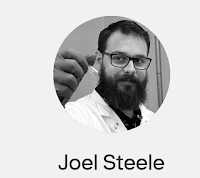"...where did the weird blogger go again...?" Not to HUPO! However, I've got something better. I found the person in our field with the first, maybe second best spy name period (there is a Dr. Roger Moore @ Rocky Mountain Labs that I've had the pleasure of working with) and he took notes for me to post here!
Meet:
HUPO 2019 secret agent and guest blog contributor! Joel is working on his PhD at UTS (not the awful east coast potato chips) this!
I'll jump back and forth between Joel's notes and my interpretations of them (I'll totally check first to see if he's okay with how I interpret and prioritize things. Disclaimer. He took a lot of notes. I might not get this all in at once (or in any order).
1) Reudi Aebersold's last presentation as lab head? I'm going to assume he's decided to do something even cooler next -- and he used this opportunity to introduce the "Modular Proteome" -- since I don't know what that is yet, we have the abstract! (Click should expand it)
A) This is huge. B) Like holy grail level huge and C) I wish I saw this talk and it sounds like it really fit in with HUPO's increasing (every year) theme -- that measuring the abundance of proteins on their own isn't what is going to get us to where we need to be.
Joel says:
2019 Study of the epi(c)Proteome
Epiproteome
(noun) “The
entire repertoire of proteins with their PTM’s in and organism/cell” ( see Sean’s
paper). The real theme of this years HUPO was our
move towards this the epiproteome and all the new tools making it possible.
A central theme of talks coalesced around this idea of an ORF protein abundance not
necessarily being the best measure of biological change, this had me thinking
that I may be conspiracy theorist.
Looking
at Rudi’s abstract was my first hint to how far we have come and his relentless
pursuit of phenotypic characterization
2) Who
is next on my conspiracy story? Chris Overall
Chris
Overall’s session on degradomics/proteases/enzymes focused on the deployment of
dimethyl labellng and TAILS strategy’s which indirectly agreed that most
proteoforms are really being missed especially in terms of alternative
cleavages. (moonlighting/multifunctional ORFS)
(Ben: Yiiiikes....I know we can automate TAILS...but it still looks so hard.... can we pretend that there is just one proteoform for every open reading frame...?)
Now
the mother of all complicated methods for an in-depth study:
Comprehensive
PTM 2.0.0.42 workflow
from Martin R Larsen showed how we are really missing a lot by not enriching
for PTMs and is his workflow is the direction we should move as a field in signaling
analyses.
(Ben: A strategy to enrich everything!??!? Let's go!)
3) Kathryn Lilley showed that a lack of
quantitative change at the protein level does not reflect aa change in function
due to location (temporal-proteomics). Lilley’s lab has now been able to
isolate the RNA that is bound to and associated with proteins giving us further
information on how there is another level of regulation we are not exploring.
But she has made headway in providing us with the “Cellular atlas of the
transcriptome and proteome”. While here I just want to point out that Kathryn’s
PhD student Mohamed Elzek has shrunk the culture requirements for the LOPIT method during his work which will make this a
feasible method for other labs to follow suit on their tissue/model of choice.
(Multi-purposing of the proteome from the slide below)
4) Michael MacCoss sold epi-proteomic
centricity the best (indirectly) by outlining that peptide centric quantitation
is the best for quantitation (Also for proteoform defining peptides). Especially
when all they are contributing differently to the signal associated to an ORF
and most of our programs take top N that agree with a magnitude and report said
value. His talk on “making quantitative proteomics quantitative” may have had a
little stir on twitter and led to an amazing thread.
5) More awesomeness from the brilliant people at the Gorshov lab:
Have
you ever been asked if you would like to win russian sweets based on your
ability to identify errors in mass spec runs at a conference? I have now.
Elizaveta
Solovyeva out of the Moscow Institute of Physics and Technology has developed a
python based QC software “Visual And Intuitive Data Quality Control” (viQC).
The software reduces multiple metrics into manageable number that allow a more
accurate identification if there is an issue with your runs, taking about a
minute per run (hg.theorchromo.ru/viQC)
Just
a note; Elizaveta is an author on the DirectMS1:
MS/MS-free identification of 1000 proteins of cellular proteomes in 5 minutes paper as well as the IdentiPy: An Extensible Search Engine
for Protein Identification in Shotgun Proteomics. If this is the QC pipeline they are
using to apply these methodologies I think it may be worth investing the small
amount of time to get it up and running in the lab. While we are on QC here are some options that have been applied
by people at HUPO in their laboratory include Panorama QC-(client-server based) and QCMAP-(web based), implementing
a QC suite was an undercurrent of many talks and is essential for clinical
proteomics going forward.
6) As we move towards multi-omics Benjamin
L Parker out of the university of Melbourne has begun a mammoth undertaking
with the genetics lipidomics and proteomics for the Hybrid Mouse Diversity
Panel, BIG THINGS COMING. Also while on the topic of Ben he also presented the NanoBlow
which is a small device for preventing contamination and keeping a mass spec
clean. (& Sean Humphrey (EASY-PHOS) and Ben Crosset)
(Ben: Cool NanoBlow picture belongs here for sure! )
Ben: This was a great idea! I have more notes to go through but this is as far as I'll probably get with this one.









No comments:
Post a Comment